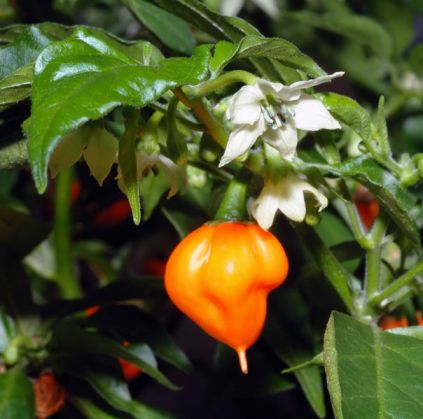Growing chiles and sweet peppers in the indoor garden is easy. Getting them to set fruit leaves many growers somewhat mystified. Either the plants never produce flowers, or all of the flowers fall off.
What’s up with that?
It would be great if there was a simple, straight forward answer to this dilemma, but the reason for your growing issues could be one or more of a number of things. Getting to the bottom of what’s going on in your grow room where pepper plants are concerned adds weight to the constant mantra that continual monitoring of everything in your indoor garden is super important.
Some capsicum are more fickle than others, and if you’ve ever grown them in a backyard garden you’ll already be aware of that. The weather really messes with your harvest. If it’s too cold, they won’t grow. If it gets too hot they aren’t real happy either. If you water them too much or too little it affects them as well, and not in a positive way. Chances are you’ve also had the issue of little to no flowering, and flowers that fall off in the outdoor garden too. It’s more tragic in the grow room, because you’ve only got a plant or two, and outdoors there is usually room for more plants – which raises the odds that you’ll will likely get a few peppers before the season ends.
Don’t create these issues in the indoor garden.
 Some types of Capsicum deal with high temperatures better than others. So how’s the temperature in your grow room, and where is your crop from exactly? Chiles and sweet peppers may have originated in Central and South America, but this vast continent doesn’t have the same heat levels everywhere. C. chinense originates in the Yucatan Peninsula of Mexico – a family that includes the most firey fruits like Habanero and Bhut Jolaka. The temperature in this region rarely gets higher than 90°F. C. annuum are for the most part the milder fruits, such as the Sweet Bell, Pepperoncini, Jalapeno, and Banana varieties.
Some types of Capsicum deal with high temperatures better than others. So how’s the temperature in your grow room, and where is your crop from exactly? Chiles and sweet peppers may have originated in Central and South America, but this vast continent doesn’t have the same heat levels everywhere. C. chinense originates in the Yucatan Peninsula of Mexico – a family that includes the most firey fruits like Habanero and Bhut Jolaka. The temperature in this region rarely gets higher than 90°F. C. annuum are for the most part the milder fruits, such as the Sweet Bell, Pepperoncini, Jalapeno, and Banana varieties.
All pepper plants are at their best in a warm, dry climate… measured your humidity lately? It needs to be at 60-80% RH. Dry outdoors is generally more humid that dry in your grow room.
Pepper plants don’t need much nitrogen, and performance will drop when the standard nutrient regimen is used. Successful growers have found that running bloom nutes from germination to the end of the harvest cycle produces happier plants and a great harvest. You’ll need to be on top of the EC level in the reservoir, as peppers have a tendency to make it climb very quickly. Air movement is a must too. If you don’t have a fan in the garden, you need one right away. Another thing known to cause poor fruiting with peppers is growing them in too small of a pot. Most types are large plants, so make sure they have room to grow, which includes not trying to cram too many of them into a small grow box.
Here’s a list of things to check in your garden and it’s environment. It could be one or several of these that is causing your Capsicum flower problems.
- Too much nitrogen
- Over watering
- Dissolved minerals in the water are too high
- Day cycle temps too high – keep it below 95°F, optimum is 77°F
- Night cycle temps too low – keep it above 65°F, optimum is 68°F
- Low light levels cause reduced fertility
- Very low humidity also causes reduced fertility
- Poor air circulation
- Insufficient pollination
- Wrong sized pot – too small to allow proper canopy growth
EC levels for best results are: 1.0 for seedlings, 2.0-2.2 once flower buds begin to form. If you’re looking for the highest heat intensity possible, 3.0-3.5 EC will do the trick, but it will also reduce the weight of your harvested fruits.